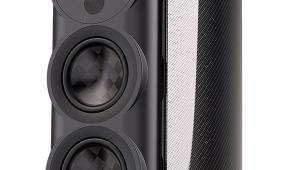Leema Acoustics Xero (£670)
Smallest of Leema Acoustics’ six-model speaker range, the Xero really is tiny at just 220x140x205mm (hwd), its front baffle having only about half the area of this magazine’s front cover. The moulding that houses the two pairs of input sockets for the split crossover occupies much of the rear panel, with just room for a small reflex port beneath, while the minuscule bass-mid driver at the front has an effective diameter of only about 80mm – little more than three inches. So this is a speaker for people with small listening rooms or who insist on their speakers having the smallest possible footprint. To this end the Xero can be wall mounted although for best sound its manufacturer rightly recommends using sturdy floor stands.
Given its size, the Xero performed quite well in the lab tests. Its low sensitivity of 83.5dB – 2dB below Leema’s specification – means that it needs a lot of amplifier volts to play loud but at least it presents a benign load with a minimum impedance modulus of 5.6ohm. Improving the effective bass extension is easily achieved by positioning the speaker close to the wall behind, Leema recommending a minimum spacing to the back panel of 100mm.
PORT OUT
The Xero’s frequency response displays a broad hump in output centred on 2kHz and a narrow notch at about 7.5kHz but the cumulative spectral decay waterfall is clean bar two well damped resonant ridges associated with small response peaks at 830Hz and 1350Hz, the former corresponding to a resonance in the port’s output. As you’d expect, the Xero’s tiny bass-mid driver generates quite high distortion when it is asked to reproduce 100Hz at 90dB SPL.
SOUND QUALITY
Grille off, as measured, the Xero has a slightly upper-mid forward tonal balance that on some sensitive recordings, like Antony Michaelson’s of the Weber clarinet quintet, can add a touch of rawness. Replacing the grilles removes this but also some of the speaker’s resolving power. Most users, I reckon, will prefer the Xeros undressed, particularly on driving rock material where the extra clarity helps their rhythmical ability, which suffers if the small bass-mid driver is asked to work too hard.
On classical music the Xeros fared well, even on full orchestral pieces like Classic Records’ Rachmaninov Symphonic Dances where their fine imaging and revealing midrange were ample compensation for any shortfall in bass weight and dynamic scale. The same was true on more intimate works like Benjamin Britten’s piquant A Ceremony of Carols where their ability to separate musical strands and project a believable stereo image with generous depth came to the fore.
I’ve lived for many years with compact speakers, if not usually this compact. With the best you learn to accept their limitations and appreciate the essential honesty of their sound. Certainly that’s the case with the Xero. Still, anybody buying speakers this size, particularly at this price, should ask themselves whether they couldn’t accommodate something a little larger and reap the benefits in dynamic scale that this can bring.
If you just must have ultra-compact speakers, the Xero is a fine choice particularly over short listening distances. It doesn’t do prodigious bass, of course, but it is musically insightful on a wide range of material. Don’t skimp on stands if you want to hear the best from it.


















































